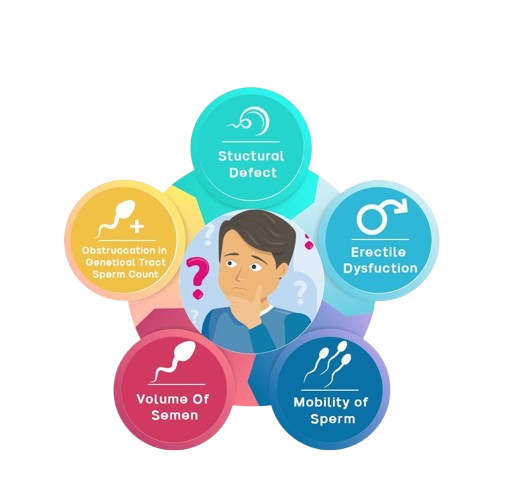Male infertility refers to a man's inability to cause pregnancy in a fertile female partner. It's typically diagnosed when a couple has been actively trying to conceive for at least a year without success. Male infertility can result from various factors, including:
A complete medical history, physical examination, and several tests to assess sperm count, motility, morphology, and the general health of the reproductive system are typically used to diagnose male infertility. The following are a few typical diagnostic tests performed to assess male infertility:
Semen analysis is a crucial test for assessing male fertility. A semen sample is collected through masturbation and analyzed in a laboratory to evaluate various parameters.
Blood tests may be conducted to measure hormone levels, including testosterone, follicle-stimulating hormone (FSH), luteinizing hormone (LH), and prolactin.
To examine the development and generation of sperm, a small piece of testicular tissue is removed during a testicular biopsy.
The primary symptoms of male infertility typically involve ejaculation disorders, leading to premature ejaculation or reduced semen volume. Additional indicators may include
The treatment of male infertility varies based on the underlying cause identified in the male partner. Male infertility specialists may recommend a range of treatments, including::
An exhaustive semen analysis is often considered a prime diagnostic tool for identifying male infertility concerns, assessing parameters such as sperm count, motility, morphology, and additional factors. Hormonal and genetic assessments may also be conducted to unveil underlying causes of infertility.
In some cases, male infertility can be attributed to genetic factors, such as chromosomal abnormalities or mutations in genes related to sperm production or function. However, not all cases of male infertility are genetic in nature.
Certainly, smoking can negatively impact male fertility by reducing sperm count, impairing DNA integrity within sperm, and diminishing motility. Consequently, discontinuing smoking is strongly advised to enhance fertility.
Chronic stress can potentially affect male fertility by disrupting hormone levels, reducing sperm quality, and affecting sexual function. Managing stress through relaxation techniques, exercise, and seeking support can be beneficial.
Signs indicating male infertility encompass challenges in conceiving following over a year of unprotected intercourse, anomalous results from semen analysis, reduced libido, erectile dysfunction, and hormonal imbalances, among others.
Common causes include low sperm count, poor sperm motility or quality, hormonal imbalances, genetic factors, infections, varicocele (enlarged veins in the scrotum), and lifestyle factors like smoking, excessive alcohol consumption, and obesity.
